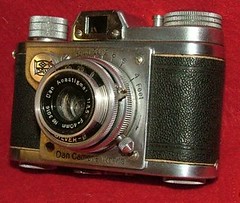Dan 35 III
The Dan 35 III (ダン35Ⅲ型) is a Japanese camera taking 24×32mm exposures,[1] released in 1949. It is an upgraded successor of the Dan 35 I and II, made in Suwa by a dependent company of Hagimoto (see the discussion about the Dan 35 I and II).
Description
The Dan 35 III has a metal body with rounded edges. It seems that the camera takes twelve exposures on perforated 35mm film loaded in special cassettes.[2] This cartridge system is probably similar to that used from 1938 on the German Photavit cameras, whose influence is perceptible on the Dan 35 M, another design by Hagimoto released around 1950. It is unclear whether the Dan 35 III can take paper-backed Bolta film as well.[3]
The viewfinder is contained in a hump in the middle of the top plate, and has a polished metal frame attached around the front window. The name Dan 35 III and the body serial number are engraved above the viewfinder, and the hump extends to the left under the film advance knob, forming a casing which contains an auto-stop advance mechanism. Frame numbers 0 to 12 are engraved on the advance knob itself, moving along an index engraved on a short cylindrical shaft. The film advance is unlocked after each exposure by a small lever protruding to the rear. There is a rewind knob at the right end of the top plate, allowing to use a single cassette and a take-up spool, the same as on regular 35mm cameras. There is a single strap lug at the right end of the body, next to the rewind knob.
The lens and shutter is mounted on a focusing helical driven by a large tab. The distance scale, graduated from infinity to 4ft, is engraved on a metal plate attached to the front of the camera by four apparent screws. This metal plate has an H DAN logo at the top, certainly standing for the personal name Hagimoto Danji, and the words Dan Camera Works at the bottom. This marking has been interpreted by some sources as the name of the manufacturer, but this probably does not correspond to any actual company, the same as other names ending in Camera Works.[4]
The shutter is a Silver-B, the same as on the Dan 35 I and II. It has the release lever on one side and the winding lever on the other. The shutter plate is black, has the speeds engraved at the top in the order 100, 50, 25, B, silver stripes on the sides and the name SILVER–B inscribed at the bottom. The lens is a coated Dan Anastigmat 40mm f/3.5.[5]
The bottom plate is removable for film loading. It is locked in place by a key, with O and L indications for Open and Locked. It has film flanges at both ends, and one of these contains the tripod thread. The words Made in occupied Japan are engraved in white letters inside the camera, at least on some occasions. The back has no red window but a metal screw, perhaps used to used to fine tune the infinity focusing during assembly or repair. The name Dan 35 is embossed on the leather covering at the bottom.
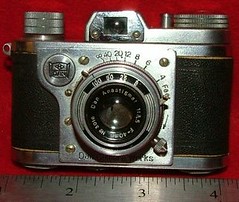 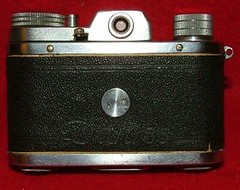 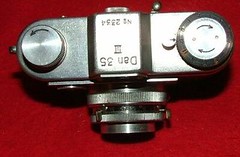
|
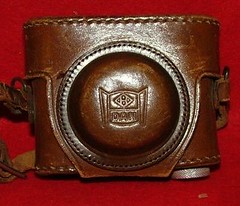  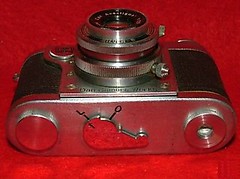
|
| Dan 35 III no.2334, Dan Anastigmat 40mm f/3.5 lens no.3016. Pictures courtesy of Antonio Casana. (Image rights) |
Commercial life
The Dan 35 III was featured as a new product in the June and August 1949 issues of Kohga Gekkan, and was advertised in Japanese magazines from October 1949 to March 1950.[6] The November 1949 advertisement in Asahi Camera, placed by Dan Shashin-yōhin, presents the Dan 35 III as a new model, along with the Dan 35 I and II, but gives no further detail.[7] The March 1950 advertisement in the same magazine gives the same company name and lists the camera together with the Dan 35 M.[8] The pictures show no serial number on the lens bezel, unlike the actual examples observed so far.
Actual examples
The only body numbers confirmed so far are no.2023, 2334 and 2838, and known lens numbers are known in the 30xx, 33xx and 39xx range. The production figures probably did not exceed a few hundred units.
Notes
- ↑ Exposure size: Kokusan kamera no rekishi, p.595; Sugiyama, item 4198.
- ↑ Special cassettes: advertisement dated March 1950 reproduced in Kokusan kamera no rekishi, p.147 and in this page at Out of Focus. The limitation to 12 exposures is suggested by the frame numbers engraved on the advance knob. Kokusan kamera no rekishi, p.354, says that the camera takes 40 exposures on regular 35mm film, but this is certainly wrong.
- ↑ Sugiyama, item 4198, and McKeown, p.242, say that the camera takes Bolta film, and do not mention the special cassettes.
- ↑ McKeown, pp.241–2, says that the Dan cameras were made by "Dan Camera Works".
- ↑ Coated lens: advertisement dated March 1950 reproduced in Kokusan kamera no rekishi, p.147 and in this page at Out of Focus.
- ↑ Kokusan kamera no rekishi, p.354.
- ↑ Advertisement reproduced in Kokusan kamera no rekishi, p.147 and in this page at Out of Focus.
- ↑ Advertisement reproduced in Kokusan kamera no rekishi, p.147 and in this page at Out of Focus.
Bibliography
- Asahi Camera (アサヒカメラ) editorial staff. Shōwa 10–40nen kōkoku ni miru kokusan kamera no rekishi (昭和10–40年広告にみる国産カメラの歴史, Japanese camera history as seen in advertisements, 1935–1965). Tokyo: Asahi Shinbunsha, 1994. ISBN 4-02-330312-7. Item 595.
- Lewis, Gordon, ed. The History of the Japanese Camera. Rochester, N.Y.: George Eastman House, International Museum of Photography & Film, 1991. ISBN 0-935398-17-1 (paper), 0-935398-16-3 (hard). P.66.
- McKeown, James M. and Joan C. McKeown's Price Guide to Antique and Classic Cameras, 12th Edition, 2005-2006. USA, Centennial Photo Service, 2004. ISBN 0-931838-40-1 (hardcover). ISBN 0-931838-41-X (softcover). P.242.
- Sugiyama, Kōichi (杉山浩一); Naoi, Hiroaki (直井浩明); Bullock, John R. The Collector's Guide to Japanese Cameras. 国産カメラ図鑑 (Kokusan kamera zukan). Tokyo: Asahi Sonorama, 1985. ISBN 4-257-03187-5. Item 4198.
Links
In English:
In Japanese:
- Dan 35 in the Out of Focus camera site (archived)
- Dan 35 III among subminiature cameras at Nekosan's website (archived)
